This Guide will teach you everything you need to know about Hydroponic Fodder.
Let’s get started…
Green fodder is essential to feed livestock, but the reduced availability of land and lack of water. It is become difficult to produce the required quantity of green fodder throughout the year. Also, the lack of quality fodder hampers the growth production, and Reproduction of livestock.
This article will learn how to Grow Hydroponic Fodder in easy steps; it will help you solve the green fodder problem.
Hydroponic fodder is produced by growing seeds without soil, and with very little water; within six-seven days, the seeds are sprouted, the seedlings will be up to 30-35 cm tall and provide highly nutritious fodder.
Advantages of hydroponic fodder
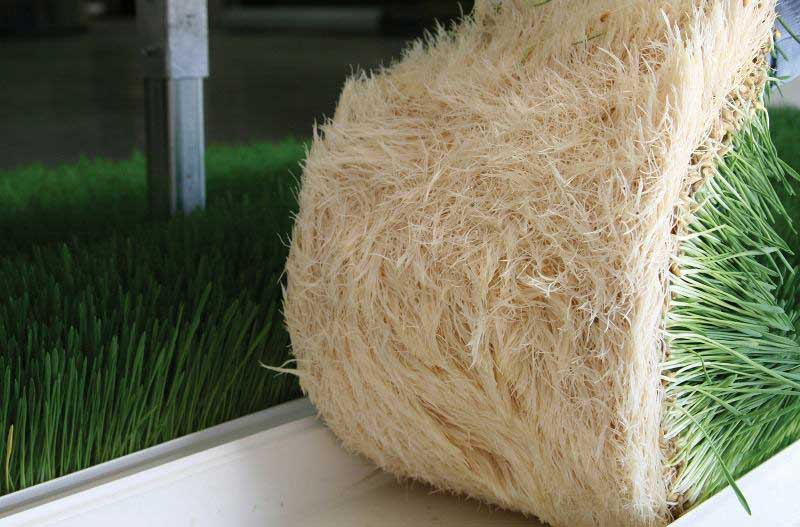
1) Nutrient Value
Hydroponics fodder has more nutrients than traditional fodder dry food or grain. It contains high carbohydrates, minerals, and vitamins.
2) Time to grow
Compared to traditional fodder, which often needs up to two months to grow, you can grow hydroponic fodder in just one week
3) less water requirement
Compared to conventional fodder production, it required less water for hydroponic fodder production. Only 3 to 4 liters of water is necessary to grow one kilogram of hydroponic fodder; on the other, for traditional fodder, approximately 70- 100liter water is required.
4) Easy daily production
Hydroponic fodder can be produced regularly throughout the year, even when low water problems.
5) Chemicals or pesticides
It does not require any chemicals or pesticides to grow
6) Less workforce and Transport cost
it needed less workforce and transport cost. most of the farmers grow hydroponic green fooder near the livestock shade

Construction of Hydroponic fodder system
To grow good quality fodder, you need to be able to control the temperature and humidity. The fodder easily grows in semi-controlled environmental conditions with a temperature range of 15-32 °C and relative humidity of 80-85%.
Also, control light is needed to grow fodder, so you need to build a small shed net or a low-cost greenhouse.
To make a shed net or a low-cost greenhouse, you can use a bamboo log, iron rod, or plastic pipe for structure construction purposes also, and you required shade netting or gunny bags to cover this structure.
Construction
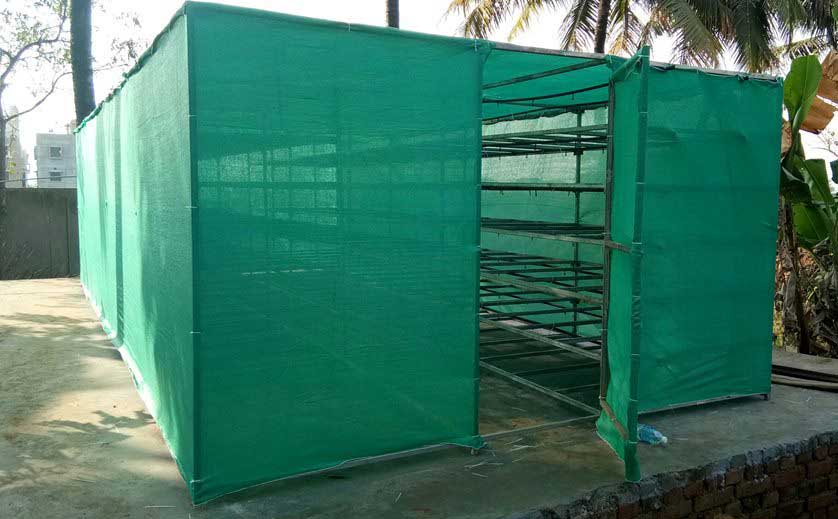
- According to your fooder quantity demand, you can build a Hydroponic fodder system. to build this system is required a little space, mostly farmers use a 10 ft x10 ft shade net to grow Hydroponic fodder, and it is better to choose a shed net location near the livestock shade because it becomes easy to operate.
- To allow ventilation to leave some open space between the roof and side walls when the shed is well ventilated and airy, you can easily maintain the temperature and humidity.
- To grow hydroponic fodder, you required a medium-size tray of about 1.5 x 3 Ft. They must be made up of good plastic and strong enough to hold the fodder’s weight.
- The seeds must be kept moist so avoid metal trays because they easily rust, so use only plastic trays.
- Make 15-20 small size holes in trays for draining any excess water.
- Inside the shed, you can build a bamboo rack, plastic rack, or metal rack to hold these trays.
- Make three to four layers rack but take care rack should not be too high because it becomes difficult to spray water and removes the trays.
- Keep enough space between two layers to easily water the seeds; also, create a slight slope for each layer to one side of the rack; this helps easily and quickly water to drain from the trays.
- Make a small drainage line under the slope side of a rack to properly drain out water.
The hydroponic fodder production process
use only good qualities of seed for hydroponic fodder production; never use broken or unhealthy seeds as these will not germinate and grow properly.
You can use maize, pulses, wheat, and horse gram seeds to make hydroponic fodder but do not use pearl millet and sorghum seeds because these sprouted leaves contain poison that can harm your livestock.
Mostly farmer uses Maize seeds to produce hydroponic fodder. In cold climatic conditions, wheat and oats seeds are good, while in hot climatic conditions, maize seeds are suitable for hydroponic fodder production.
Process
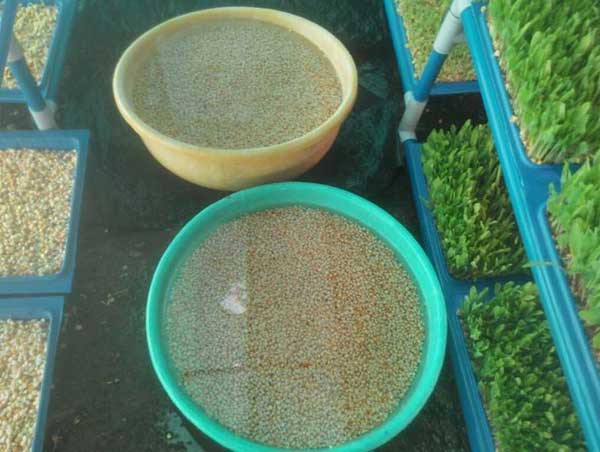
- Add 5-7 liters of warm water in a plastic bucket and seed and remove seeds are float on the water because they will not sprout also remove other impurities.
- After that, add 50 -100 gm salt in water; it helps minimize fungus production on the sprouted seed.
- Allow this seed to soak water for around 12 hours.
- After 12 hours, drain the water and then wash the seeds with clean water.
- Transfer this washed seed to a gunny bag and allow them to sprout. In a cold climate, they will take more than 24 hours to germinate, while in a hot climate, the seed will take about 24 hours.
- Before using the tray, wash them properly and check all holes if they are blocked or not. If there is a blockage, remove the blockage.
- Transfer sprouted seeds from the gunny bags to trays and evenly spread them, and place them on the rack.
- Every day gives light water ( sprinkle) to sprouted seeds. To provide water, you can use watering cans or a sprinkler system.
- In hot weather conditions, give water after every two hours, and in cold weather conditions, after 4 hours, it helps maintain moisture.
Always maintain cleanness in the shed; it helps to reduce fungus, mold development chances.
Please do not disturb the trays’ sprouted seeds until they are harvesting, which influences the fodder’s growth.
Within seven days from one tray containing one kilogram of maize seed, you can produce about eight kilograms of fodder.
When preparing hydroponic fodder to make the rack according to your fooder need, if you required every day five trays of fodder so for seven days, a prepared shade accommodates 35 trays.
Feeding of Hydroponic Green Fodder
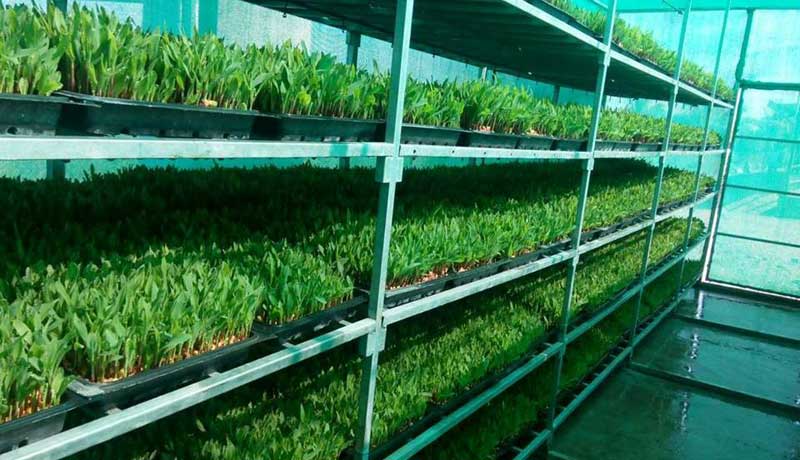
In six to seven days, the fooder is ready to harvest, take out fodder slabs from the tray, and cut them into small pieces before feeding it to the livestock, so it is easier for the animals to eat the fodder properly.
Avoid keeping the fodder for more than nine days in the trays because, after nine days, the nutrient value of fodder starts to decrease slowly, and fiber starts to develop.
Give this fooder to livestock along with other food and dry fodder from the total quantity of fodder.
Give this fodder to the livestock with other food and other dry fodder. Farmer gives the combination of half a hydroponic fodder and half fodder or dry fodder.
Hydroponic fodder is very soft and nutritious, and tasty, and the resulting animals enjoy it.
Conclusion
For sustainable dairy farming, quality green fodder should be fed regularly to dairy animals. Hydroponic fodder is a good option in front of the farmer because it grows fast, it contains a high nutrient value, and the most important thing is animals like to eat.

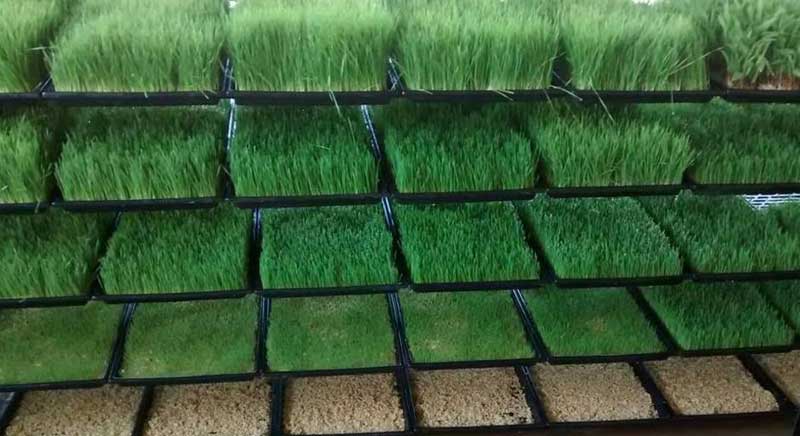

Sir, some people on youtube are saying that, we can’t maintain temperature by using green net and use polycarbonate sheet or glass to make hydroponic house, is it wrong to use green net?
Hello Laxmikant,
polycarbonate sheet or glass very effective for control temperature but the cost of polycarbonate sheet or glass is high so the green net is a cost-effective solution for Hydroponic fodder.
Hi sir
Above steps doesn’t mention adding nutrients to the seeds or water
Does it mean that maize doesn’t require any nutritional but just water
Regarding how to get maize seeds
Could I used corn ? seeds or does it has to be special seeds
Also could you please advise which is one has better nutrition maize or barley seeds
Hi Bile,
There is no requirement to add nutrient in the fodder production process
Thanks for the research
Thank you sir
If you have excess fodder can you pack it like silage and use it at a later time?
No Sir, it is suitable for fresh use only.
Thanks for this very interesting and important write up, I’m happy to have it.
Thank You, Abubakar
Between Barley and maize which one is better?
Hello Aine,
Maize is better.
Thanks for this write up we really appreciate thanks once again
Thanks for the information sir,
Please I want to know the process of using sorghum, Millet, barley and maize for hydroponics, are the process the same ways and days.
Thanks once more sir, best regards
For sorghum, Millet, barley, and maize same procedure
Hello sir what is the gap between two trays?
Hi Manish,
There is a very small or no gap requried.
Instead of choosing green house, can it be grown in an RCC built rooms of sizes 20×20×10?
Yes, you have to maintain humidity and temperature.
A very good narrative
Thanks a lot sir
Thank you
This your write-up gives me much hope as I am an aspiring livestock producer; very interesting, sir. Thanks for the effort.
Thank you
How can I turn hydroponic fodder into a money making business,i am in Nigeria, and can cows feed on this fodder everyday
Yes
Thanks for the literature,can livestock feed on this fodder 100%?
Hello Charles,
You can use 50-70% green fooder livestock feed, but not 100%.
Thanks for the info dear
Thank you
Really good info, thank you sir.
Thank You
Thank you so much
Good
I like this thing
I’m from Uganda
Good for you, Nicholas
Thanks for your helpful words
Thank you
Informative writeup
Thank you
Thank you very much Mr. Amar for the very elaborative explanation. This ha s given me an insight on the hydroponic feed project.
Be blessed for sharing.
Thank you
Hello.
All information were helpful.
Thanks for advance.
I like your presentation can I feed ducks with it? If yes how often?
Yes, it is suitable for ducks, you can give 10%-30% in daily meals.
Thank you for sharing. Great piece of information
Kindly can I feed my chickens and goats daily with hydroponics.
Thank you
yes
This is a great step-by-step process, may your Ink never dry. Cheers
Thank you
amar sawant
Really interesting information. Thank you sir
Thank you
Hi, how to get rid off bad smell in fodder and keep away some sort of insects.
Maintain hygienic condition and use good quality water.
A very good narrative. Thank you very much for this!
Philibert
Thank you
Sir, can i use handpump water for irrigation of hydrophonic fodder or anything required to add in normal water?
Use normal water only
Thanks for this Detailed information. What can I use in place of a gunny bag?
Gunny bag is required but if you don’t find Gunny bag use any cloth bag.
dear Mr. Amar
Thank you for good guide.
Is this need to light in 24 hours? Totally light must be on in 24 hours or not?
Hello Vahid,
24-hour light is not required. It will increase your production cost.
Thank you so much, it’s a great piece.
Good for thought and very helpful
Impressive literature
Good information,thanks a lot.
Many thanks for your knowledge and willing to share. Following your literature, we started growing fodder for cows approx 100 kg per day in a RCC shed using GI trays. we notice seed becoming black after 4th or 5 th day and leaves becoming pale yellow in color. What could be the reason. Can we also have a consultation with you.
sure, contact us @ 8788462787